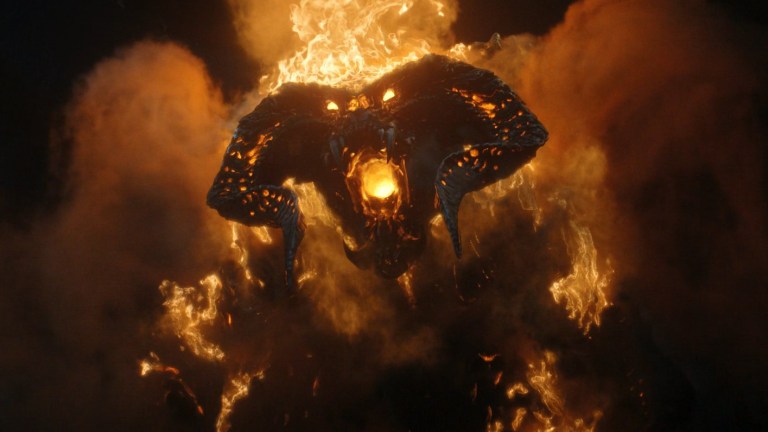The Rings of Power: How the Balrog Changes Lord of the Rings Canon
The Balrog has arrived in Khazad-dûm...but a bit earlier than expected, according to what we know about Lord of the Rings history.

This Lord of the Rings article contains spoilers for The Rings of Power.
At the end of episode 7 of The Rings of Power, we saw an image that will be chilling to fans of either Peter Jackson’s movies or Tolkien’s legendarium: a Balrog stirring under the Dwarf mines of Khazad-dûm. But what exactly is this fiery monster and how does it relate to the rest of Tolkien’s world?
In Tolkien’s mythology, Balrogs are corrupted Maiar. The Maiar are spirits created by Ilúvatar (God) to help the Valar (also spirits, but more powerful, a bit similar to pagan gods and goddesses) to shape the world. The Maiar are less powerful than the Valar and they more or less work for them. When one of the Valar, Morgoth, rebelled and turned to the Dark Side, he corrupted some of the Maiar and turned them into Balrogs.
Since Morgoth has some broad similarities with the Christian figure of Lucifer, the fallen angel who rebelled against God, it’s not surprising that the Balrogs are a bit like Christian demons, and Tolkien called them “demons of terror” in The Silmarillion. The Balrog that lives under the mines of Moria will be very familiar to anyone who has read The Lord of the Rings or seen any of its adaptations, because it is the one that Gandalf so memorably fought on the Bridge of Khazad-dûm.
Tolkien described the Balrog that Gandalf fought as, “like a great shadow, in the middle of which was a dark form, of man-shape maybe, yet greater… The flames roared up to greet it, and wreathed about it; and a black smoke swirled in the air. Its streaming mane kindled, and blazed behind it. In its right hand was a blade like a stabbing tongue of fire; in its left it held a whip of many thongs.” In The Silmarillion he said “their hearts were of fire, but they were cloaked in darkness… they had whips of flame.”
The exact appearance of the Balrog, which Tolkien left so thoughtfully vague, was the subject of some controversy among Tolkien fans when the Peter Jackson adaptation of The Fellowship of the Ring came out because of one detail – wings. In the book, Tolkien said that “the shadow about it reached out like two vast wings,” and then, barely half a page later, “its wings were spread from wall to wall.” And so began decades of speculation – does the Balrog have wings or does the shadow around it just look like wings? And if it does have wings, why does it fall into a chasm when Gandalf fights it?
Ralph Bakshi famously gave the Balrog fairly substantial wings in his 1978 animated adaptation of the first half of The Lord of the Rings. Meanwhile, Jackson attempted to have his cake and eat it by giving his Balrog shadowy wings, so that it wasn’t clear whether they were actual physical wings or just part of the smoke and shadow surrounding the Balrog – just like Tolkien’s text! So far The Rings of Power has gone the same route as Jackson, as the images shown while Gil-galad is describing the fight between an Elf hero and a Balrog show smoky bat-like wings looming behind the Balrog, but it’s not clear how substantial they are.
Gandalf is also a Maiar, like the Balrogs once were, as are Sauron, Saruman, Radagast, and the mysterious Blue Wizards whom Tolkien never seemed to write much about. So when Gandalf fights either Sauron or a Balrog, it’s a rare occasion that sees him fighting a being just as powerful as himself, which is why defeating the Balrog in The Fellowship of the Ring actually kills him, and his spirit later has to be returned to Middle-earth by Ilúvatar as Gandalf the White.
Exactly how many Balrogs there were in existence was another of those topics that Tolkien kept changing his mind about. In early drafts, later published in The Book of Lost Tales, he imagined there were hundreds, or even thousands of them. For most of The Silmarillion, they are always talked about in the plural – it’s usually “Balrogs” running around doing evil in a large group – and there’s a character called Gothmog, Lord of Balrogs, which suggests there are quite a few around for him to be Lord of. The parallels with Christian demons from Hell are fairly clear there.
However, towards the end of The Silmarillion, Tolkien says that the Balrogs were destroyed, “save some few that fled and hid themselves in caverns inaccessible at the roots of the earth.” Presumably he intended this as an explanation for the Balrog that was disturbed when the Dwarves mined too deeply in Moria, and which Gandalf later fought. Christopher Tolkien wrote in his History of Middle-earth that his father had put a note in a margin saying that actually there should have only ever been 3 or at most 7 Balrogs in existence at all. Considering, as Maiar, they ought to be on the same level of power as Gandalf or Sauron, that would actually make more sense, but since it was only a late note in the margin, it’s more likely The Rings of Power will go with the other explanation – that most of them were destroyed at an earlier time.
The story Gil-galad tells Elrond about the Balrog under Moria in episode 5 – that an Elf and a Balrog were fighting over a special tree and were struck by lightning – doesn’t come from Tolkien’s legendarium, which is probably why Gil-galad ever so slightly cheekily tells Elrond it is “an obscure legend, regarded by most to be apocryphal.” It has some similarities with the story of the Elf hero Glorfindel fighting and killing a Balrog at a high mountain pass and being killed in the process (he gets better) but the tree – although, again, similar to some other Tolkien trees – and the story as a origin story for mithril is a new invention.
It seems pretty clear that the series is saying that their invented Balrog is the one now lurking under Moria, eventually to be killed by Gandalf, but not for many centuries. The only problem is that, in Tolkien lore, it’s said the Balrog wasn’t actually awoken by the Dwarves until the Third Age, meaning he’s risen in The Rings of Power an age too early. Known as Durin’s Bane after slaying King Durin VI, the Balrog’s reign of terror inside the mines is what forces the Dwarves to eventually abandon Moria, which is why it’s deserted by the time the Fellowship arrives to travel through it.
While the Balrog might be up a little earlier than expected, it’s been clear from the start that The Rings of Power would carve its own path when it came to the history of Middle-earth, even confirming that the timeline of the Second Age would be condensed for the purposes of the TV series.
Co-showrunner J.D. Payne explained his reasoning for the compressed timeline to Vanity Fair back in February: “If you are true to the exact letter of the law, you are going to be telling a story in which your human characters are dying off every season because you’re jumping 200 years in time, and then you’re not meeting really big, important canon characters until season four. Look, there might be some fans who want us to do a documentary of Middle-earth, but we’re going to tell one story that unites all these things.”
That still doesn’t quite explain why the Balrog has awoken in the Second Age instead of the Third Age, but by tying the Balrog’s presence to the existence of mithril itself (which was rare but could also be found in Númenor in Tolkien’s lore), the series is looking to create a more coherent story following the creation of mithril as a result of a battle with a Balrog, to the attempt to mine it in order to save the Elves, to the awakening of the same Balrog. Either way, it remains a demonic, fiery creature, which just leaves one question – will it have real, physical wings?!
The Lord of the Rings: The Rings of Power is streaming now on Amazon Prime Video.
